Andersen Windows AN74I, AN74IX User Manual
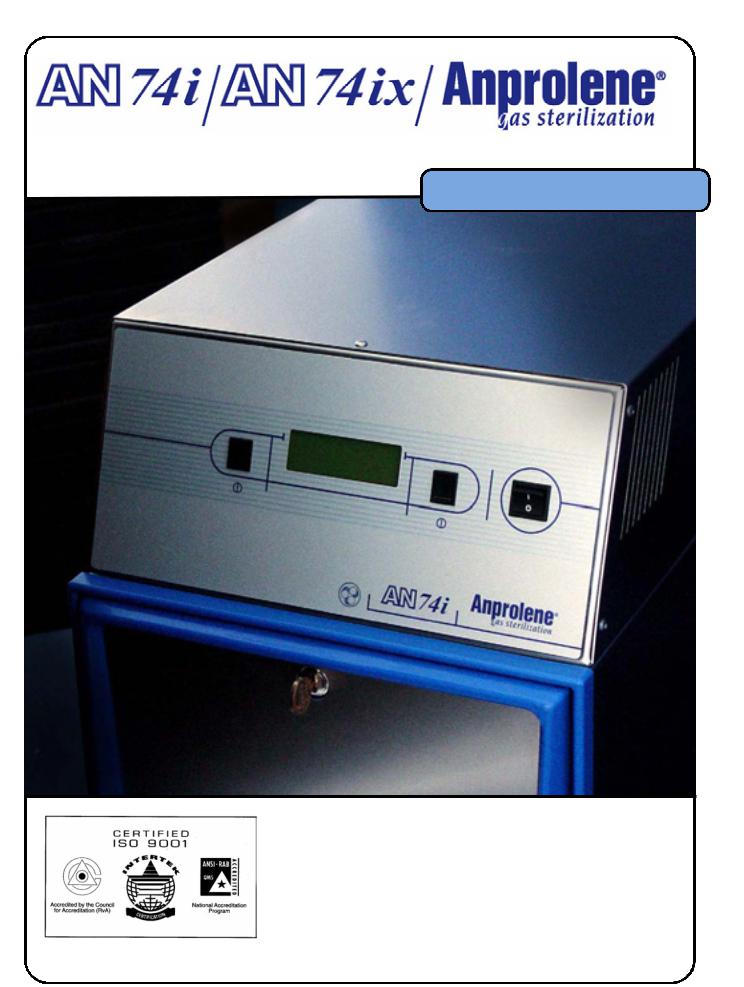
OWNER’S MANUAL
OWNER’S MANUAL
5/25/2005 11:38 AM
AN2000manual071603bgf
ETHYLENE OXIDE
STERILIZATION SYSTEM
P/N7400 041105
Andersen Sterilizers, Inc. Health Science Park Haw River, NC 27258-8710
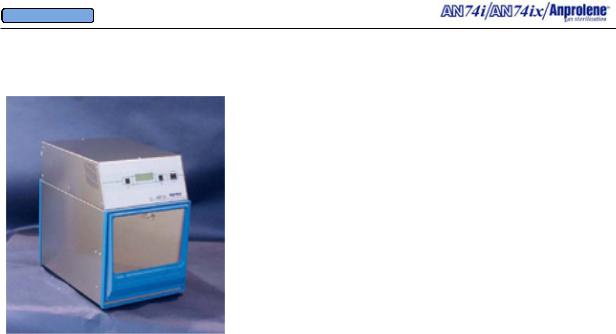
OWNER’S MANUAL
Owner’s Manual
Congratulations on your purchase of an AN74i / AN74ix Anprolene® Sterilizer. For over 30 years, Andersen Products has been a leader in tabletop Ethylene Oxide sterilization. With the installation of your sterilizer, you join thousands of healthcare facilities worldwide using an Andersen Products’ sterilization system.
Please read the entire Owner’s Manual prior to installing and using your new machine.
The Andersen Anprolene sterilizer uses less than 20% of the amount of Ethylene Oxide gas of our nearest competitor (less than 18 grams). However, please note that Ethylene Oxide can be hazardous if not properly handled. Ethylene Oxide is also highly flammable, so precautions should be taken to avoid improper installation or operation of the equipment near spark or open flame.
Knowing how to properly use the Anprolene system is important. With this in mind, we have included the Operator Training and Education Section found in Section 4, beginning on page 17. Illustrated instructions and information on humidification are included in the training section. In addition, you will also find information concerning the Andersen Key Operator Certification Program. The Key Operator Program covers all aspects of effective use of your Anprolene sterilizer and is offered free of charge for the lifetime of the sterilizer. After reviewing the enclosed training material, please call 800-523-1276 or 336-376-3000 to schedule your exam. Outside the United States and Canada, please contact your local distributor.
A list of suggested items that can be sterilized in the Anprolene sterilizer can be found on pages 28 and 29 of this manual. CAUTION: Food and drugs may not be sterilized because Ethylene Oxide may change their chemical composition. If you are not certain about an item’s suitability for Ethylene Oxide sterilization, please contact an Andersen Customer Service Representative.
Section 6 of this manual covers Troubleshooting and Error Messages and begins on page 34. Installation requirements and instructions are discussed in Appendices B through D, beginning on page 46.
Please call Customer Service at 800-523-1276 or 336-376-3000 for repair services. Outside the United States and Canada, please contact your local distributor.
Instructions on preparation of products prior to sterilization appear in Section 1, beginning on page 5.
Accessories for use with your Anprolene sterilizer can be found in Section 5, beginning on page 30.
WARNING! If the Anprolene sterilizer is not installed and operated in the manner specified by Andersen Products, the protection provided by the equipment may be seriously impaired.
DANGER! Ethylene Oxide is a Cancer and Reproductive hazard. Refer to MSDS on page 68 and EPA approved labeling on all Anprolene refill kits for complete instructions and warnings.
In case of emergency, please call Andersen Products Customer Service at 336-376-3000 during regular business hours (EST). After business hours, please contact 800-255-3924.
2
© Andersen Products Ltd
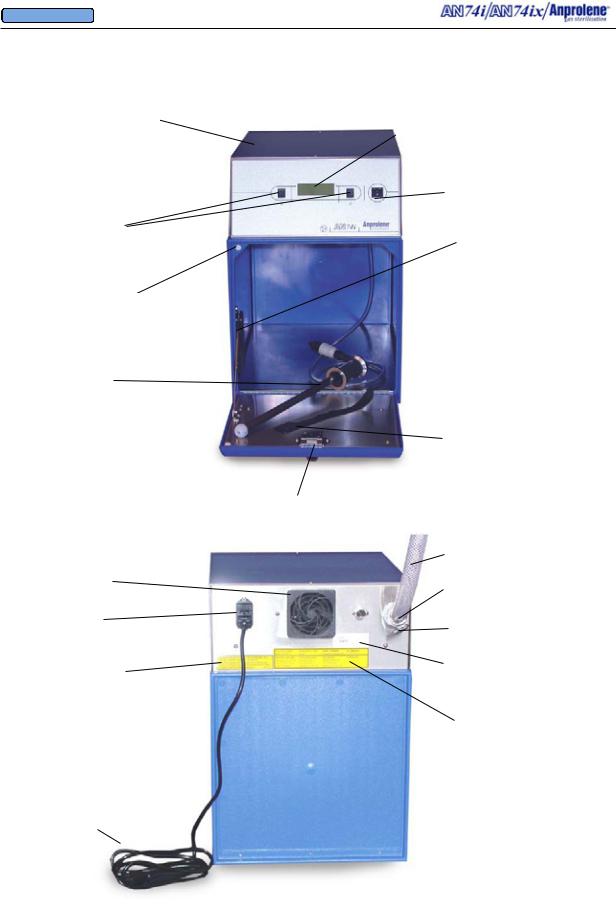
OWNER’S MANUAL
Top Cabinet
Program Selection
Switches
Door Sensor
Purge Tube
Assembly
Cooling Fan Guard
and
Removable Filter
Fuse Drawer
Replacement
Fuse
Specifications
Detachable
Grounded
Power Cord
Overview of Features
Back Lighted
Liquid Crystal Display
On/Off switch
Door Support
 Quick Disconnect
Quick Disconnect
Velcro® strap
Latching Door Lock
3/4” (1.91 cm) I.D. Exhaust Tubing
Stainless Steel
Hose Clamp
Rear 3/4” I.D. Bulkhead
Exhaust Fitting & 90 Deg
Elbow
Underwriters Laboratories’ Approval Label
Electrical
Connection
Requirements
3
© Andersen Products Ltd

OWNER’S MANUAL |
|
TABLE OF CONTENTS |
|
Introduction ............................................................................................................................ |
2 |
Overview of Features.............................................................................................................. |
3 |
Section 1 - Before You Begin................................................................................................. |
5 |
Section 2 - Diagrammatic Instructions for Normal Operation ............................................... |
8 |
Section 3 - Detailed Pictorial Instructions for Running the Sterilization Cycle................... |
12 |
Section 4 - Operator Training and Education....................................................................... |
17 |
Section 5 - Sundries for Use with Anprolene....................................................................... |
30 |
Section 6 - Warnings, Troubleshooting, Error Messages and Alarms ................................. |
34 |
Section 7 - Maintenance ...................................................................................................... |
42 |
Appendices |
|
A - Technical Features.......................................................................................................... |
44 |
B - Installation Requirements ............................................................................................... |
46 |
C - Installation Instructions for New Anprolene Users ........................................................ |
49 |
D - Installation Instructions for Current Anprolene Users ................................................... |
55 |
E - Flow Chart for Normal Operating Screen....................................................................... |
59 |
F - Material Safety Data Sheets............................................................................................ |
68 |
G - AN74 i/ix Specifications ................................................................................................ |
74 |
H - Equipment Ratings Summary and Replacement Parts List............................................ |
77 |
I - Andersen One Year Limited Warranty............................................................................ |
80 |
J - Useful Life of Sterilizer is Ten Years.............................................................................. |
83 |
4
© Andersen Products Ltd
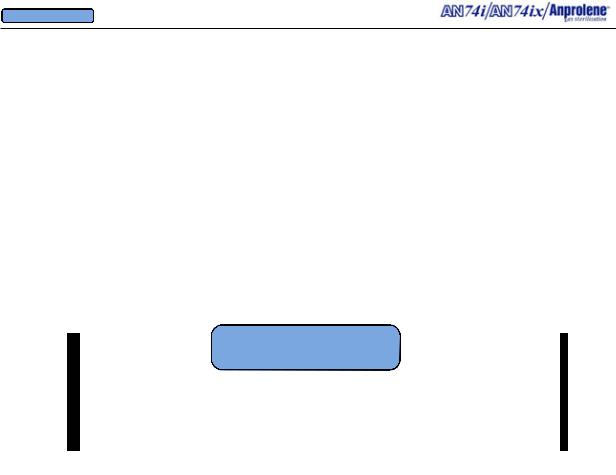
OWNER’S MANUAL
SECTION 1
Before You Begin...
5
© Andersen Products Ltd

OWNER’S MANUAL
SECTION 1
Before You Begin
There are a number of conditions that can affect the operation of your sterilizer. By paying close attention to these details, you will greatly reduce the likelihood of problems.
1.1.Installation: Please make sure that your Anprolene sterilizer is installed correctly. Full installation instructions can be found in Appendix B, starting on page
46.Please call our Customer Service Department if you have installation questions not covered in this section.
1.2.Environmental Factors: Your Anprolene sterilizer is designed to operate at room temperature (68°F/20°C to 91°F/33°C ). Please pay close attention to the following factors:
a.Temperature: Ethylene Oxide (EtO) is sensitive to temperature and becomes less effective at lower temperatures. Make sure that the room where the sterilizer is installed maintains a temperature between 68°F/20°C and 91°F/33°C for the full duration of the sterilization cycle.
b.Humidity: Anprolene sterilization requires at least 35% relative humidity
(RH). In low humidity areas, or during the winter months when the humidity level drops, an Andersen Humidichip® may be necessary to achieve and/or maintain the proper humidity level in the sterilization liner bag. Please refer to Section 4, beginning on page 17, for more information on humidity and pre-humidification.
1.3.Preparing Items for Sterilization: Materials to be sterilized by all Ethylene Oxide sterilizers, including Anprolene, must be meticulously cleaned and dried.
Coatings of dried proteins such as pus, blood or feces protect microorganisms and slow the sterilization process. Precautions must always be taken before sterilization with Anprolene. To prepare items for sterilization, please include the following steps:
a.Disassemble - Anprolene is a highly diffusible gas sterilant; nevertheless, occlusive caps, plugs and stylets must be removed from instruments so that the gas can penetrate freely. Hollow bore needles and plastic or rubber tubing must be open and free from stylets and plugs. Syringes must be packaged with the plungers removed.
b.Wash - Scrub the disassembled instruments in detergent and water to the most critical standard of cleanliness possible. We recommend the use of an enzymatic cleaner such as Andersen Products’ AN2281 Surgical Instrument Enzymatic Detergent, which may be used with most materials.
c.Dry - Water on instruments at the time of exposure to Anprolene may react with the gas and reduce its effectiveness. Make sure that items to be sterilized are physically dry before wrapping and processing. Towel drying or drain drying is sufficient. CAUTION: Do not use hot air to dry.
d.Wrap - All items to be sterilized must be wrapped in cloth, paper or plastic in
the manner conventional for steam sterilization, or in Andersen Seal and Peel® Packaging.
6
© Andersen Products Ltd

OWNER’S MANUAL
SECTION 1
Before You Begin
There are a number of conditions that can affect the operation of your sterilizer. By paying close attention to these details, you will greatly reduce the likelihood of problems.
1.1.Installation: Please make sure that your Anprolene sterilizer is installed correctly. Full installation instructions can be found in Appendix B, starting on page
46.Please call our Customer Service Department if you have installation questions not covered in this section.
1.2.Environmental Factors: Your Anprolene sterilizer is designed to operate at room temperature (68°F/20°C to 91°F/33°C ). Please pay close attention to the following factors:
a.Temperature: Ethylene Oxide (EtO) is sensitive to temperature and becomes less effective at lower temperatures. Make sure that the room where the sterilizer is installed maintains a temperature between 68°F/20°C and 91°F/33°C for the full duration of the sterilization cycle.
b.Humidity: Anprolene sterilization requires at least 35% relative humidity
(RH). In low humidity areas, or during the winter months when the humidity level drops, an Andersen Humidichip® may be necessary to achieve and/or maintain the proper humidity level in the sterilization liner bag. Please refer to Section 4, beginning on page 17, for more information on humidity and pre-humidification.
1.3.Preparing Items for Sterilization: Materials to be sterilized by all Ethylene Oxide sterilizers, including Anprolene, must be meticulously cleaned and dried.
Coatings of dried proteins such as pus, blood or feces protect microorganisms and slow the sterilization process. Precautions must always be taken before sterilization with Anprolene. To prepare items for sterilization, please include the following steps:
a.Disassemble - Anprolene is a highly diffusible gas sterilant; nevertheless, occlusive caps, plugs and stylets must be removed from instruments so that the gas can penetrate freely. Hollow bore needles and plastic or rubber tubing must be open and free from stylets and plugs. Syringes must be packaged with the plungers removed.
b.Wash - Scrub the disassembled instruments in detergent and water to the most critical standard of cleanliness possible. We recommend the use of an enzymatic cleaner such as Andersen Products’ AN2281 Surgical Instrument Enzymatic Detergent, which may be used with most materials.
c.Dry - Water on instruments at the time of exposure to Anprolene may react with the gas and reduce its effectiveness. Make sure that items to be sterilized are physically dry before wrapping and processing. Towel drying or drain drying is sufficient. CAUTION: Do not use hot air to dry.
d.Wrap - All items to be sterilized must be wrapped in cloth, paper or plastic in
the manner conventional for steam sterilization, or in Andersen Seal and Peel® Packaging.
7
© Andersen Products Ltd
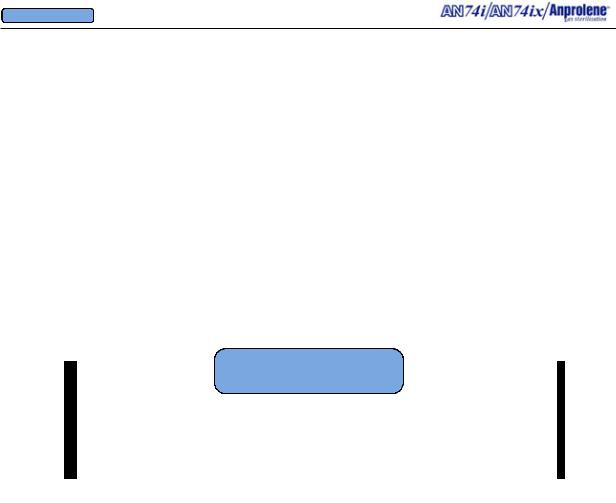
OWNER’S MANUAL
SECTION 2
Diagrammatic Instructions
for Normal Operation
8
© Andersen Products Ltd

OWNER’S MANUAL
SECTION 2
Diagrammatic Instructions for Normal Operation
Turn on the sterilizer by pressing the on-off switch on the back right side of the top cabinet.
The Liquid Crystal Display will illuminate. The initial startup and standby screen is shown to the right.
To load the sterilizer and commence a sterilization cycle, press the button immediately to the right of the word START.
AN74 I
ANPROLENE STERILIZER
START
When START is pressed
If an abator is attached to the machine, the number of cycles remaining for the abator cartridge will be displayed. A new abator cartridge may be used for a maximum of 250 sterilization cycles.
The display will indicate that the sterilizer has performed a self test on the cabinet ventilation pump and ventilation switch. The version of the computer software is shown (VER 4.04). In addition, the total number of hours that the ventilation pump has been operating is shown (35 PUMP HOURS). This information is used to determine when preventive maintenance should be performed. (See Section 7). The cooling fan blade speed is displayed as a percentage of nominal operating speed (FAN 97% RPM).
Once the self test of the cabinet ventilation pump has been successfully completed, the display will show the instructions for loading the sterilizer. After the sterilization bag has been secured to the purge tube bobbin via the Velcro strap, press the button to the right of the word PURGE to evacuate air from the sterilization bag.
The display will show the initial 1 minute, 30 second initial purge is in progress. To stop the cycle and return to the standby screen, press the button to the left of the word EXIT.
© Andersen Products Ltd
250 ABATOR CYCLES
REMAINING
SELF TEST
VER 4.04
35 PUMP HOURS FAN 97 % RPM
SELF TEST
OK
35 PUMP HOURS FAN 97 % RPM
LOAD STERILIZER BAG
CLOSE BAG OVER TUBE
PURGE BAG
EXIT PURGE  When PURGE pressed
When PURGE pressed 
INITIAL PURGE
00:01:30 REMAINING
EXIT
Continued on next page
9
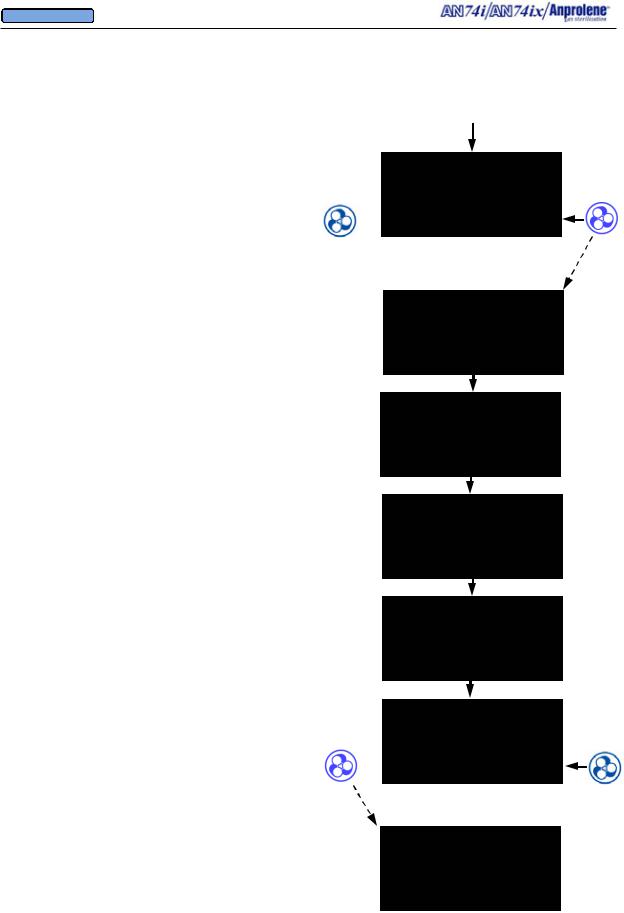
OWNER’S MANUAL
Diagrammatic Instructions for Normal Operation, continued
After the initial purge, the screen to the right will appear. If the operator breaks the ampoule and closes the door without selecting a cycle length, the sterilizer will beep after 5 seconds to remind the operator to select the appropriate cycle length. The operator should break the Anprolene ampoule, close the sterilizer door, remove the key, and select the desired cycle length.
Once the sterilization cycle has been initiated, the display will show the cycle length chosen and the time remaining in the sterilization cycle.
Continued from previous page
BREAK AMPOULE
CLOSE & LOCK DOOR
SELECT CYCLE LENGTH  24 HOUR 12 HOUR
24 HOUR 12 HOUR
When 12 hour cycle length selected
12 HOUR CYCLE
STERILIZING
11:24:15 REMAINING
12 HOUR CYCLE
STERILIZING
11:24:15 REMAINING
At the end of the sterilization cycle, the unit will begin a 2 hour sterilization liner bag ventilation (purge) cycle to remove the residual Ethylene Oxide. The display will show the time remaining in the purge cycle. During this time the purge pump and cabinet ventilation pumps will run alternating two minute cycles.
VENTILATING BAG
01:59:55 REMAINING
At the end of the 2 hour liner bag ventilation (purge) cycle, the machine will beep once and instruct the user to UNLOAD STERILIZER, signifying the end of the cycle. The sterilizer may now be safely unloaded.
Note - Additional Aeration Option:
The ventilation pump and purge pump continue running alternating two minute cycles until the door is opened and the EXIT button is pressed. If needed, items may be left in the machine for further aeration after the cycle has ended by simply leaving the items inside the sterilizer. The count-up timer indicates the additional aeration time.
Once the cycle has been concluded by opening the door and pressing the EXIT button, both pumps will stop running and the sterilizer will return to the standby screen.
UNLOAD STERILIZER
00:08:54
EXIT
UNLOAD STERILIZER
01:29:30
 EXIT
EXIT
When EXIT pressed
AN74 I
ANPROLENE STERILIZER
START
10
© Andersen Products Ltd
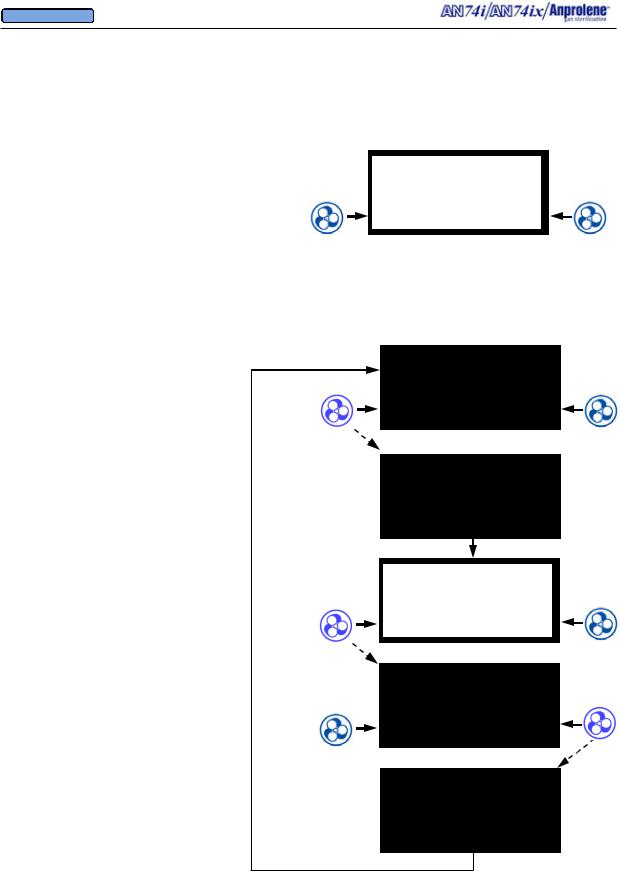
OWNER’S MANUAL
Diagrammatic Abator Instructions:
Installing Optional New Abator Cartridge, Resetting Counter
When the Abator cartridge has been used completely (250 sterilization cycles), the screen will display ABATOR CARTRIDGE EXPIRED and the alarm will sound.
Additional cycles may be completed by bypassing the screen. This is not recommended. The cartridge should be changed prior to starting a new cycle.
ABATOR CARTRIDGE
EXPIRED
EXIT BYPASS
Once a new cartridge is installed, the counter must be reset.
To reset the counter:
1. Hold the left button continuously for more than 3 seconds
2.Press ABATOR button
3.Answer YES to the question: INSTALL NEW ABATOR CARTRIDGE
AN74 I
ANPROLENE STERILIZER
|
PARAMETERS |
START |
When |
|
|
left button |
|
|
pressed and held |
DIAGNOSTICS |
|
for more than 3 |
|
|
seconds. |
ABATOR ATTACHED |
|
PRESS ABATOR TO
INSTALL CARTRIDGE,
OTHERWISE PRESS DIAG
ABATOR DIAG
INSTALL NEW
ABATOR CARTRIDGE
NO |
YES |
CARTRIDGE COUNTER
RESET TO 250
11
© Andersen Products Ltd
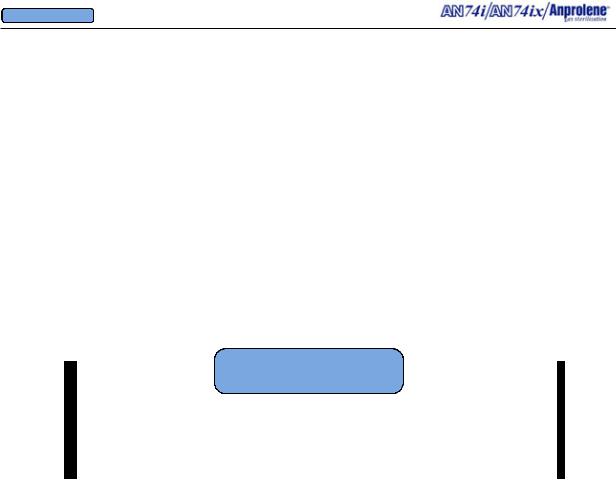
OWNER’S MANUAL
SECTION 3
Detailed Pictorial Instructions for Running a Sterilization Cycle
12
© Andersen Products Ltd
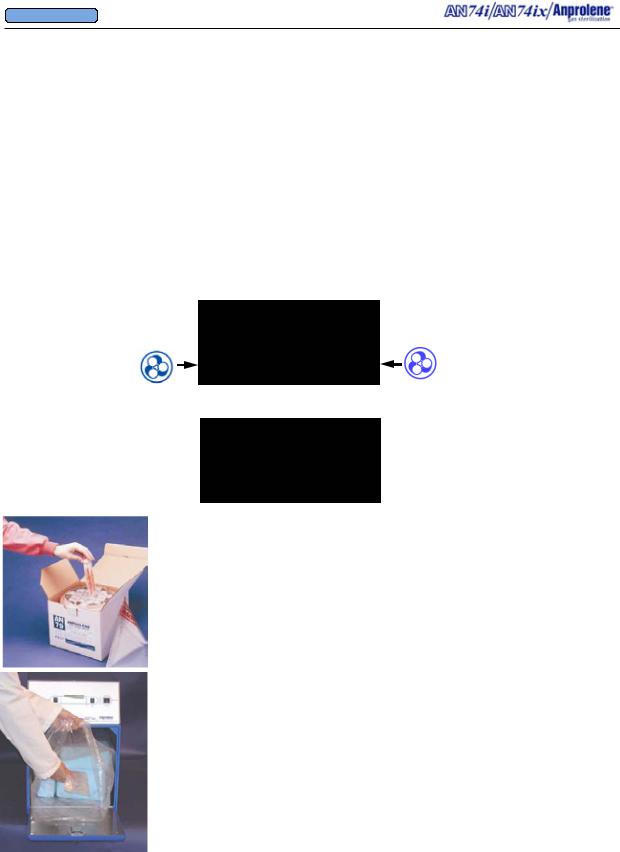
OWNER’S MANUAL
SECTION 3
Detailed Pictorial Instructions for Running the Sterilization Cycle
Once the items to be sterilized have been disassembled, cleaned, dried and wrapped, the sterilization cycle can proceed.
3.1 Prior to loading the sterilizer: (1) Turn the power ON by pressing the right side of the black power switch located on the back right corner of the machine. This will cause the initial screen to appear. (2) Press the button to the right of START on the display screen to initiate the self test.
AN74 I
ANPROLENE STERILIZER
START
Upon successful completion of the self test, the following LOAD screen will be displayed:
LOAD STERILIZER BAG
CLOSE BAG OVER TUBE
PURGE BAG
EXIT PURGE
3.2.Preparation and loading of the sterilization liner bag:
a.Remove a sterilization liner bag from the refill kit and place it inside the sterilizer cabinet with the open end facing you.
b.Place the wrapped items for sterilization inside of the sterilization liner bag.
c.Unroll the gas release bag containing the gas ampoule.
d.Without opening the gas release bag, gently move the ampoule to the center of the gas release bag.
e.Place the gas release bag on top of the wrapped items so that you can easily manipulate it through the wall of the bag after the sterilization liner bag has been closed. Do not break the ampoule at this time.
f.Place appropriate indicators inside of the sterilization liner bag. (See Section 5 for more information concerning sterility indicators.)
13
© Andersen Products Ltd
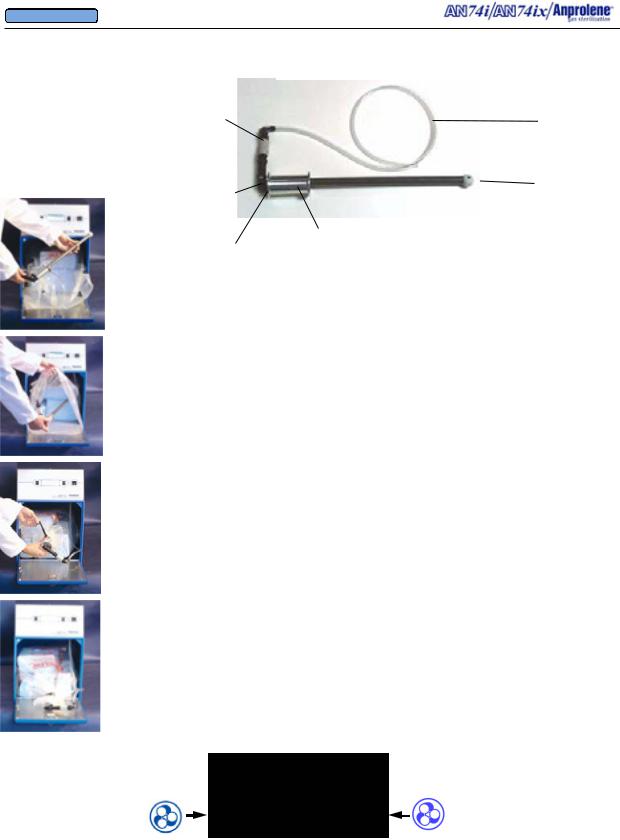
OWNER’S MANUAL
PURGE TUBE ASSEMBLY
Quick Release Connector (Female end)
Purge tube, this end is connected to upper cabinet.
Quick Release Connector (Male end)
One-way Check valve
End Goes
Into Liner
Bag
Neck. Wrap the sterilization bag around aluminum bobbin and secure with the Velcro strap
3.3. Insert the purge tube into the sterilization liner bag with the plastic ball towards the rear of the bag and the neck towards the opening. Then, gather the open end of the sterilization liner bag around the aluminum neck of the purge tube, taking care to ensure you have left no openings.
3.4. Slip the black Velcro® strap around the outside of the sterilization liner bag and thread the pointed end of the strap through the square black loop. Pull the Velcro strap firmly and then wind it back around the exposed surface of the strap. Make sure that the Velcro strap is secure and provides an airtight seal between the aluminum neck of the purge tube and sterilization liner bag.
3.4.a. This is how the secured sterilization liner bag and purge tube should appear.
3.5. If the purge tube has been disconnected from the sterilizer by means of the quick release, simply reattach it by pressing the male and female ends together until they click.
3.6. With the cabinet door open, press the PURGE button.
LOAD STERILIZER BAG
CLOSE BAG OVER TUBE
PURGE BAG
EXIT PURGE
14
© Andersen Products Ltd

OWNER’S MANUAL
INITIAL PURGE
00:01:30 REMAINING
EXIT
3.8. After the initial purge has been completed (timer to 00:00:00), the display instructs the operator to: (1) break the ampoule by manipulating the ampoule gas release bag through the wall of the sterilization liner bag, (2) close the door, and (3) lock the door and remove the key.
3.9. Select the length of the sterilization cycle. For most items, the 12 HOUR cycle will be adequate.
BREAK AMPOULE
CLOSE & LOCK DOOR SELECT CYCLE LENGTH 24 HOUR 12 HOUR
3.10. When sterilizing lengths of tubing greater than 3 feet (91.5 cm) or loads containing gas absorbent materials, the extended length 24 hour cycle should be used. Large volumes of gas absorbent materials (rubber and plastic) also require the use of an additional Anprolene ampoule and the extended 24 hour cycle. To operate the sterilizer using the extended 24 hour cycle, press the button to the left of 24 HOUR. The display will then show STERILIZING 24:00:00 REMAINING.
24 HOUR CYCLE
STERILIZING
24:00:00 REMAINING
3.11. The sterilization cycle will then begin. Note: After the ampoule is activated and the door is closed, if the operator does not select a cycle length within 5 seconds, a continuous alarm will sound to remind the operator to select the appropriate cycle time.
12 HOUR CYCLE
STERILIZING
11:24:15 REMAINING
3.12. At the end of the 12 (or 24) hour cycle, the cabinet ventilation pump will stop and the purge pump will run for two minutes, flushing Ethylene Oxide from the sterilization liner bag. Then the purge pump will stop while the cabinet ventilation pump runs for two minutes. This alternating cycling of the purge and cabinet ventilation pumps will continue for a period of two hours. This will be displayed as shown below and will count down to 00:00:00.
VENTILATING BAG
01:59:59 REMAINING
15
© Andersen Products Ltd
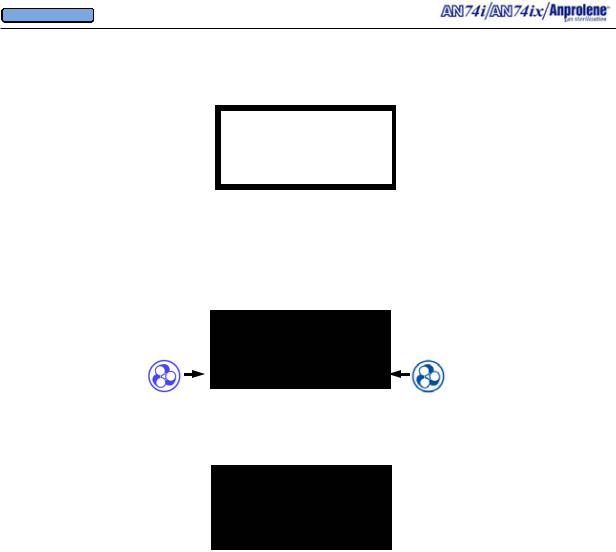
OWNER’S MANUAL
3.13. At the end of the two hour ventilation cycle, the following screen will appear, notifying the operator that the sterilizer may be unloaded.
UNLOAD STERILIZER
EXIT
3.14. If the operator does not unload the sterilization liner bag at the end of the two hour ventilation cycle, the purge pump and the cabinet ventilation pump continue to alternate on a two minute cycle to flush the sterilization liner bag and cabinet indefinitely until the door is opened and the EXIT button is pressed This feature may be used for Additional Aeration. Refer to page 45.
UNLOAD STERILIZER
EXIT
3.15. If the operator opens the door after the two hour purge cycle is complete and presses EXIT , both pumps will stop and the program will automatically return the sterilizer to the start screen.
AN74 I
ANPROLENE STERILIZER
START
3.16. To unload the sterilizer, open the door and remove the Velcro® strap from around the neck of the purge tube. Remove the purge tube from the sterilization liner bag. Unload the wrapped items from the sterilization liner bag and place them on a shelf in a well-ventilated room that has a minimum of 10 air changes per hour of fresh makeup air.
3.17. Gas absorbent materials such as rubber or plastic must be aerated in their individual packages for at least 24 additional hours before they are used.
3.18. The used gas release bag ampoule and sterilization liner bag may be disposed of in ordinary rubbish. Never reuse sterilization liner bags.
16
© Andersen Products Ltd
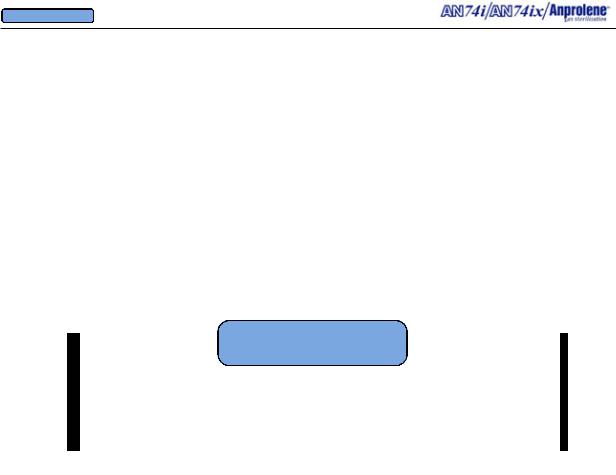
OWNER’S MANUAL
SECTION 4
Operator Training and Education
17
© Andersen Products Ltd

OWNER’S MANUAL
SECTION 4
Operator Training and Education
♦Ethylene Oxide sterilization procedures must be supervised by personnel trained and well informed in the safe use of such sterilant materials.
♦Personnel working with ethylene oxide must have had comprehensive instruction in the process. This instruction must cover the relevant health hazards (See MSDS on page 68), relevant national regulations (e.g. OSHA regulation 29 CFR Part No. 1910 Standard No. 1910.1047), methods for safe use and methods to detect escape of sterilant material (e.g. AN 93 Airscan Badges)
♦Regular in-service programs relating to the process must be conducted and an attendance record and evidence of understanding must be kept for each employee (e.g. Andersen Key Operators Test).
18
© Andersen Products Ltd

OWNER’S MANUAL
4.1Humidity and Pre-humidification
4.2Abridged Illustrated Instructions
4.3Key Operator Study Guide
4.1. Humidity and Pre-humidification.
It has been demonstrated repeatedly that some microorganisms are made very resistant to Ethylene Oxide sterilization systems by desiccation, which is exposure to very low relative humidity.
As a result, humidity is a very important part of the Ethylene Oxide sterilization cycle. Items that can be washed in water and towel or air dried will not need pre-humidification.
Items that may be damaged by immersion in water or a sterilization load that contains a large amount of material that will absorb water (dry paper and cloth) will need pre-humidification.
Process for Pre-Humidification Using an Anprolene Sterilization Liner Bag
a.Items that cannot be immersed in water should be disassembled and wrapped in the usual way.
b.Place the prepared items along with a Humidichip® inside a sterilization liner bag. Using a twist tie or Velcro® strap, securely close the neck of the bag.
c.Leave the items in the bag for a minimum of four hours at a temperature of 68°F /20°C or higher. Pre-humidification may take place outside the sterilizer cabinet. Take caution not to rip or puncture the sterilization liner bag.
During the sterilization cycle, use a Humidichip to ensure a minimum of 35% Relative Humidity inside the sterilization liner bag. Items that did not need pre-humidification can be added to the sterilization liner bag, along with the appropriate controls such as Dosimeter®, Steritest®, or other Biological Indicators. If there is any question as to the integrity of the sterilization liner bag, use a new liner bag for the sterilization cycle.
19
© Andersen Products Ltd
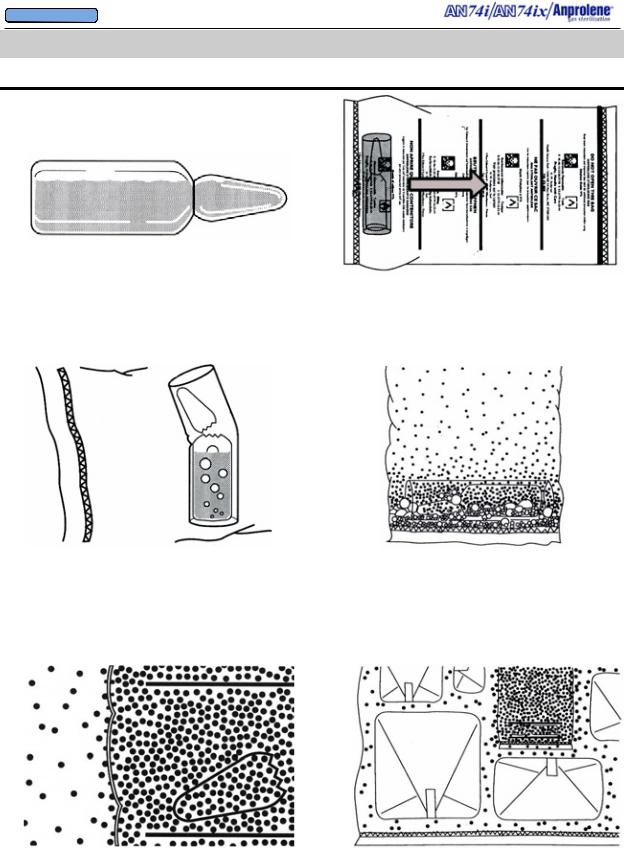
OWNER’S MANUAL
4.2 ABRIDGED ILLUSTRATED INSTRUCTIONS
HOW ANPROLENE WORKS
1. The glass ampoule contains liquid Ethylene Oxide (EtO) and an inert solid stabilizer. The ampoule is scored at the neck for easy opening.
3. After the gas release bag is placed inside of the sterilization liner bag and it is secured to the purge bobbin, the sterilization bag is then vacuumed down. To release pure EtO gas, manually snap off the top of the ampoule by manipulating it through the walls of the sterilization liner bag. The plastic/fabric shield prevents the broken glass of the opened ampoule from puncturing the gas-release bag.
5. Since the walls of the gas-release bag are permeable only to EtO gas and not the inert solid stabilizer, only the 100% pure EtO gas diffuses through the walls of the gas-release bag and into the liner bag.
2. A plastic/fabric break shield surrounds the ampoule. The ampoule and shield are sealed inside a plastic gasrelease bag, which should never be opened.
IMPORTANT! Push the ampoule to the center of the gas release bag before activating
4. The liquid EtO then boils, releasing 100% EtO gas within the gas-release bag, leaving residual deposits of the previously dissolved inert solid stabilizer.
6. EtO possesses great kinetic energy, which causes the gas molecules to spread out to every cubic centimeter of the liner bag by their own velocity.
20
© Andersen Products Ltd
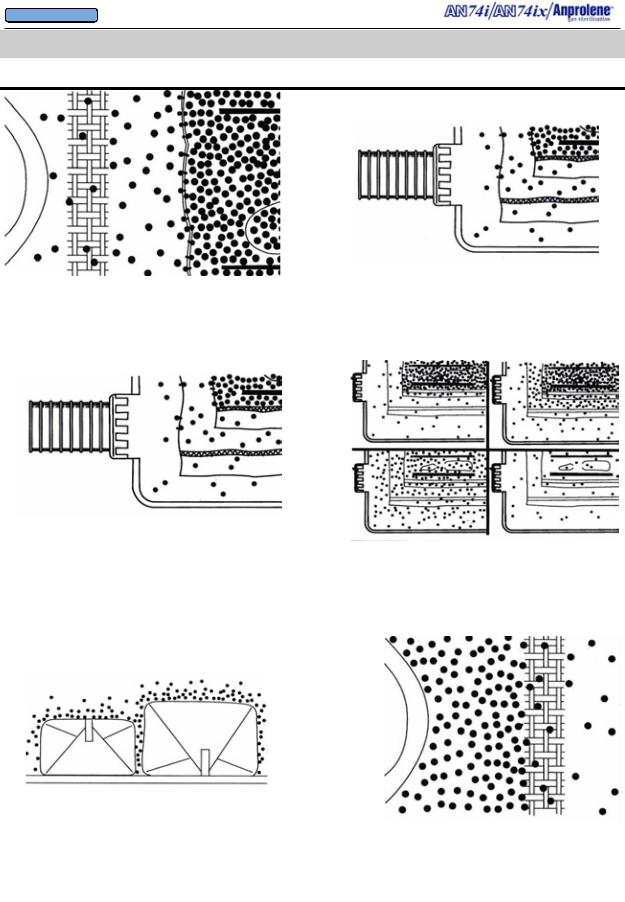
OWNER’S MANUAL
4.2 ABRIDGED ILLUSTRATED INSTRUCTIONS
HOW ANPROLENE WORKS
7. EtO gas readily passes through cloth, paper, and Seal and Peel® Packaging to reach the items to be sterilized.
9. The EtO molecules diffusing from the liner bag into the sterilization cabinet are then evacuated to the abator, if installed. Any remaining effluent is then vented to the outside atmosphere by the sterilizer’s ventilation system.
11. At 12 hours, all items are sterile, and the residual gas in the liner bag is small. The additional two-hour purge cycle is used to remove remaining residual EtO from the liner bag before the container may be opened.
8. The walls of the sterilization bag are also porous to EtO gas. As the concentration of EtO gas in the liner bag is increased by gas diffusing from the gas-release bag, the EtO molecules also diffuse through the walls of the liner bag and into the sterilization cabinet.
10. For about three hours there are more EtO molecules released into the liner bag than are released by the liner bag into the sterilizer. Then the rates are similar for three hours. Finally, the liquid Anprolene in the gas-release bag is exhausted. EtO molecules gradually diffuse into the sterilizer for the remainder of the cycle.
12. Gas-absorbent materials, like plastic and rubber, are aired in their protective wrapping before use. The EtO gas absorbed by plastic or rubber readily escapes through cloth, paper, or Seal and Peel® Packaging.
21
© Andersen Products Ltd

OWNER’S MANUAL
4.3 Key Operator Study Guide:
AN74I / IX Anprolene® Sterilizer
Thank you for using the Anprolene® sterilization system.
The active ingredient in Anprolene is ethylene oxide (EtO or EO), a chemical that can be hazardous if not handled properly. To ensure that you fully understand the safe operation of your sterilizer, we strongly encourage you to take advantage of our Key Operator certification program.
To begin Key Operator training, please read through this study guide thoroughly. If you do not understand any of the information in the guide, please call Andersen Customer Service for assistance. Once you are familiar with the study guide, you can call us at (800) 523-1276 to schedule a test.
The test will take approximately 20 minutes. The Key Operator test is also an excellent opportunity to ask your Andersen Representative any questions you may have about your Anprolene system or ethylene oxide.
When you successfully complete the test, you will receive a certificate and a registered key ring. We look forward to hearing from you.
Key Operator training is free of charge for the lifetime of your sterilizer. Please have all new operators of your Anprolene sterilizer contact us for training before they use the system.
22
© Andersen Products Ltd
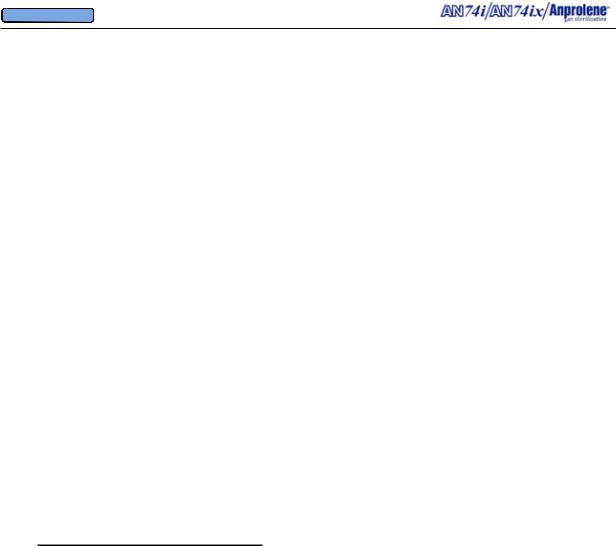
OWNER’S MANUAL
A.Environmental Considerations
1)Temperature
•Store your Anprolene gas refill kits in a cool, secure area. We recommend storage below 72°F (22.2°C).
•The sterilizer must be used in an area where the temperature is not less than 68ºF (20°C) or more than 91ºF (33°C). This temperature range must be maintained during the entire sterilization cycle.
EO FACTS: At sea level, ethylene oxide is a liquid below 51 ° F (10.6.° C).
Above 51 ° F, EO begins to boil and converts into a gas. EO does not become an effective sterilant until 68 ° F (20 ° C) Make sure that the room where your Anprolene sterilizer is installed remains above 68 ° F during the entire 12-hour sterilization cycle. This is especially important during the winter months!
2)Humidity
•Humidity is very important to the Anprolene process. Relative Humidity (RH) must be at least 35% in the room where item preparation and sterilization take place. Spores that might be on the instruments may become very dry and resistant to Anprolene if the RH is below 35%.
•The simplest way to humidify items is to wash them.
•It is necessary to humidify items which cannot be washed by enclosing them in a plastic bag with an Andersen Humidichip® or a damp sponge for four hours prior to sterilization at a temperature greater than 68 ° F (20 ° C)
B.Preparing Items for Sterilization
Four basic steps must always be followed when preparing items for sterilization:
1)Disassemble
2)Wash
3)Dry
4)Wrap
1)Disassemble
Items containing removable parts, such as syringes, must be taken apart before washing, drying, and wrapping them to allow the Anprolene an unobstructed path.
WARNING!: Instruments which contain batteries should be taken apart and the batteries removed and wrapped separately to protect against a spark occurring and igniting the ethylene oxide gas.
2)Wash
Items must be washed surgically clean prior to sterilization. For cleaning, we recommend using an enzymatic detergent such as Andersen’s Sterizyme (AN2281).
23
© Andersen Products Ltd

OWNER’S MANUAL
3) Dry
Two accepted ways to dry any item prior to sterilization with Anprolene are:
1.Towel drying
2.Drain drying (air drying).
WARNING!: Heat or hot air should never be used to dry an item prior to sterilizing it with Anprolene because it will dehydrate or dry out bacteria spores making them more resistant to the ethylene oxide gas.
WARNING!: Any water left on items may react with ethylene oxide, reducing its efficacy. Please air dry instruments thoroughly.
4)Wrap
The following types of wrapping material are recommended for use with Anprolene:
1.Andersen Seal and Peel® Packaging (which is airtight and waterproof and greatly extends the shelf life when heat sealed at both ends)
2.Cloth (like CSR wrap) has an estimated sterile shelf life of 30 days
3.Paper (self-seal pouches) has a shelf life of 30 days
4.Tyvek-paper pouches
☺HINT: Exposure indicators such as the Andersen AN85 or AN86 will turn color in the presence of EO, helping to later identify items that have been sterilized.
C.Sterilization Cycle
1)Preparing the Sterilization Liner Bag
1.Place prepared items in a new sterilization liner bag.
WARNING!: Do not reuse sterilization liner bags. Even a tiny pinhole in a sterilization liner bag can allow gas to escape and cause cycle failure!
WARNING!: Do not sterilize liquids, foods or drugs in the Anprolene sterilizer. If you have any questions about whether an item may be sterilized using Anprolene, please call Andersen Customer Service.
2.Insert appropriate controls such as a Dosimeter (chemical indicator) or a Steritest®
(biological & chemical indicator) into the least accessible part of the sterilization liner bag. Add a Humidichip® if appropriate.
3.Unroll the gas release bag containing the gas ampoule and, without opening it, gently move the ampoule to the center of the gas release bag. Place it on top of the items in the sterilization liner bag where it will be easy to break.
24
© Andersen Products Ltd

OWNER’S MANUAL
4.Insert the purge tube into the sterilization liner bag with the aluminum bobbin and quick release fitting at the open end. Place the black Velcro® strap around the sterilization liner bag and the bobbin of the purge tube, and pull it snug though its loop to close the sterilization liner bag. The strap must secure the sterilization liner bag tightly around the aluminum bobbin to keep gas from escaping.
5.Connect the quick release connector to the purge tube, if it is not already connected.
☺HINT: The sterilization liner bag may be loaded and sealed away from the sterilizer cabinet, and connected to the purge tube once you are ready to start a cycle.
2)Starting the Cycle
1.Make sure the AN74 i/ix power cord is connected. Press the right side of the power switch located on the right rear of the cabinet. Wait to see the ‘AN74 I ANPROLENE STERILIZER’ and the ‘START’ message to appear on the cabinet display.
2.Push the button to the right of START.
3.Wait for the SELF TEST and number of elapsed PUMP HOURS to appear. (If above 18,000 hours, call Andersen for service.)
4.Press the button to the right of the PURGE message on the display and wait for the time to count down from 1 minute 30 seconds to ‘00:00:00’. The sterilization liner bag should compress as excess air is removed.
5.When the display indicates “BREAK AMPOULE,” carefully, so as not to puncture the sterilization liner bag, grasp the ampoule through the sterilization liner bag and activate it by snapping off the top.
3) Selecting Cycle Length
1.Close the door.
2.Lock the sterilizer and remove the key.
3.SELECT CYCLE LENGTH. (Right button = 12 Hour, Left button = 24 Hour)
WARNING: The usual Anprolene sterilization cycle is 12 hours, plus a 2-hour purge cycle. When sterilizing lengths of tubing 3 feet (91.4 cm) or longer, or a full load of gas absorbent items, it may be necessary to increase the cycle time to 24 hours with the ‘24 HOUR CYCLE’ button and to use two ampoules.
4.If an electronic beep sounds, it is an alert that 5 seconds have elapsed and the AN 74 i/ix is awaiting a 12/24 hour cycle time selection.
5.Log sterilization data if required.
WARNING: Never interrupt a cycle once the gas ampoule has been activated. An alarm will sound if the door is opened during the cycle.
25
© Andersen Products Ltd

OWNER’S MANUAL
4)Unloading the Sterilizer and Determining Sterility
1.Remove the sterilized items only after the sterilization cycle and 2-hour purge cycle have been completed and the display indicates UNLOAD STERILIZER. The sterilizer will continue to aerate items that are not removed immediately. A count-up timer on the display will indicate the time that has lapsed since the final 2-hour purge cycle ended.
☺HINT: To unload the sterilization liner bag away from the sterilizer, simply detach the purge probe hose from the bag using the quick release fitting at the base of the purge probe.
2.Close the sterilizer door and press EXIT to turn off the AN74 i/ix.
3.Unload the liner bag and check the sterility (chemical &/or biological) indicators.
•Steritest provides an immediate indication of the success of the cycle (via the Dosimeter), and later proves sterility by showing that active spores have been killed. (Spores will require at least 48 hours of incubation to provide results.)
•The Dosimeter shows whether time, temperature and gas concentration parameters have been met. It provides an immediate chemical indication that the cycle was successful. Dosimeters should not be used in place of biological indicators to prove sterility.
•Chemical exposure indicators, such as the AN85 or AN86, do not prove sterilization. They only change color to show that the items have been exposed to ethylene oxide.
4.Spent ampoule may be disposed of in regular trash.
☺HINT: While you may not reuse sterilization liner bags, they make great heavyduty trash bags!
D.Aeration
•The cabinet ventilator should be running during the entire sterilization cycle to prevent personnel from being exposed to more than the OSHA permitted levels of ethylene oxide. [1.0 ppm (parts per million) over an 8 hour time weighted average (TWA)] Do not remove items before the full 2-hour purge cycle. Aeration should take place in a well-ventilated area that provides at least 10 fresh air exchanges per hour so that high concentrations of gas will not build up while aerating. The purge cycle is designed to aerate most products sufficiently to meet the short-term exposure level (STEL) of 5.0 ppm for the 15-minutes (while unloading the liner bag).
•Metal and glass do not require additional aeration. However, items made of gas absorbent material must be aerated at a minimum room temperature of 68° F (20° C) for at least 24 hours prior to use. Any ethylene oxide retained in an item could cause a serious chemical contact burn to the patient.
26
© Andersen Products Ltd
